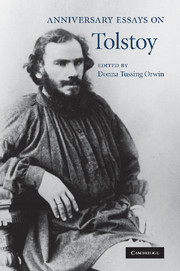Book contents
- Frontmatter
- Contents
- Acknowledgments
- List of contributors
- Introduction
- 1 Tolstoy and music
- 2 Sublime vision and self-derision: the aesthetics of death in Tolstoy
- 3 Tolstoy's peaceable kingdom
- 4 Leo Tolstoy: pacifist, patriot, and molodets
- 5 Leo Tolstoy's correspondence with Nikolai Strakhov: the dialogue on faith
- 6 The worm of doubt: Prince Andrei's death and Russian spiritual awakening of the 1860s
- 7 Tolstoy's spirituality
- 8 Tracking the English novel in Anna Karenina: who wrote the English novel that Anna reads?
- 9 Violence and the role of drama in the late Tolstoy: The Realm of Darkness
- 10 What men quote by: Tolstoy, wise sayings, and moral tales
- 11 The “proletarian lord”: Leo Tolstoy's image during the Russian revolutionary period
- Bibliography
- Index
3 - Tolstoy's peaceable kingdom
Published online by Cambridge University Press: 03 May 2010
- Frontmatter
- Contents
- Acknowledgments
- List of contributors
- Introduction
- 1 Tolstoy and music
- 2 Sublime vision and self-derision: the aesthetics of death in Tolstoy
- 3 Tolstoy's peaceable kingdom
- 4 Leo Tolstoy: pacifist, patriot, and molodets
- 5 Leo Tolstoy's correspondence with Nikolai Strakhov: the dialogue on faith
- 6 The worm of doubt: Prince Andrei's death and Russian spiritual awakening of the 1860s
- 7 Tolstoy's spirituality
- 8 Tracking the English novel in Anna Karenina: who wrote the English novel that Anna reads?
- 9 Violence and the role of drama in the late Tolstoy: The Realm of Darkness
- 10 What men quote by: Tolstoy, wise sayings, and moral tales
- 11 The “proletarian lord”: Leo Tolstoy's image during the Russian revolutionary period
- Bibliography
- Index
Summary
Tolstoy stands before us as a monumental chronicler of the human experience throughout every stage of life as individual, as member of a complex society, as seeker after truth through philosophy, religion, and art. But the other animals of the biosphere are also essential to Tolstoy's vision; man is, as characters like Pierre or Levin realize full well, merely one link in the great chain of being. The animal kingdom permeates Tolstoy's written world – as it did his actual existence – in myriad and often contradictory ways. Animals helped shape his views of art, death, happiness, life, history, causality, order and chaos, friendship, relations between men and women, morality, and philosophy – indeed all the preoccupations that alternately perplexed Tolstoy, drove him to despair, and gave his life meaning. Animals figure in countless permutations but are always close to the center of his ruminations.
This chapter begins by tentatively exploring ways in which Tolstoy's ideological views on animals mesh with those of some philosophers and writers who are interested in these questions today. The question of animal rights and the degree to which animals resemble human beings has reengaged philosophers and scientists in the past several decades, perhaps as a result of what has been learned about animal behaviors and the animal brain.
My primary interest, however, is in Tolstoy's representations of animals in his fiction. Animals are essential to Tolstoy's framing of aesthetic, moral, social, personal, and philosophic questions.
- Type
- Chapter
- Information
- Anniversary Essays on Tolstoy , pp. 52 - 75Publisher: Cambridge University PressPrint publication year: 2010

